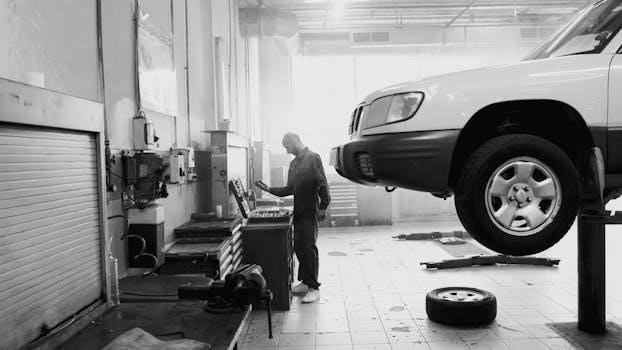
auto mechanic labor rate guide
Welcome to the ultimate guide on auto mechanic labor rates! This resource is designed to equip auto shop owners with the knowledge needed to set competitive and profitable labor rates. Stay informed about market trends, regional differences, and economic factors influencing mechanic wages.
Auto mechanic labor rates are a cornerstone of the automotive repair industry, influencing both business profitability and customer costs. Understanding these rates is crucial for auto shop owners aiming to stay competitive while maintaining healthy profit margins. These rates reflect the cost of the skilled labor required to diagnose, repair, and maintain vehicles, encompassing the expertise and time invested by mechanics.
This guide will delve into the factors shaping labor rates, from regional economic conditions to the growing complexity of modern vehicles. By exploring state-by-state analyses and pricing strategies, we aim to provide a comprehensive overview of how labor rates impact the automotive repair sector. Whether you’re an experienced shop owner or new to the industry, this guide will equip you with the knowledge needed to navigate the complexities of labor rate pricing.
Furthermore, we will discuss the importance of balancing profit margins with customer expectations, ensuring that your pricing strategies attract customers while sustaining your business. Utilizing auto repair estimator software for accurate pricing and staying competitive in a changing market will also be explored. This introduction sets the stage for a detailed exploration of auto mechanic labor rates in 2024.

Factors Influencing Labor Rates in 2024
Several key factors significantly influence auto mechanic labor rates in 2024. These encompass economic conditions, state-specific labor laws, and the ever-increasing complexity of vehicle technology. Regional economic health plays a vital role, as areas with higher costs of living typically demand higher wages for mechanics to maintain a reasonable standard of living. The demand for skilled mechanics in a particular area also impacts rates; higher demand often drives prices up.
State labor laws and regulations exert considerable influence, with states having stricter laws, such as California, facing higher baseline costs for employing mechanics. The cost of operating a business, including rent, utilities, and insurance, also contributes to the overall labor rate. Furthermore, the growing complexity of modern vehicles, particularly with the rise of electric vehicles (EVs), necessitates specialized training and equipment, which in turn affects labor costs.
Shops must invest in updated tools and ongoing training for their technicians, adding to the overhead. Finally, competition within the local market influences pricing strategies, pushing shops to balance profitability with attracting and retaining customers. By understanding these multifaceted factors, auto repair shop owners can more effectively navigate the complexities of setting competitive and sustainable labor rates in 2024.
State-by-State Analysis of Auto Repair Labor Rates (2024)
In 2024, auto repair labor rates exhibit significant variation across different states, influenced by diverse economic, regulatory, and market factors. States with higher costs of living, such as California, tend to have the highest labor rates, ranging from $155 to $175 per hour, reflecting the increased expenses mechanics face for housing, transportation, and other necessities. Conversely, states with lower costs of living, like Mississippi, may see rates around $150 to $155.
States in the Northeast, including New York and New Jersey, typically have higher rates, ranging from $135 to $145 per hour, due to stringent labor laws and higher operating costs. In the Southeast, rates can vary widely; for example, North Carolina may have lower rates ($85-$105 per hour), while Georgia and Florida could be in the $140-$150 range. Midwestern states like Illinois and Michigan generally see rates from $125 to $145.

Remote states such as Alaska and Hawaii face unique challenges, including higher import costs and geographic isolation, leading to rates in the $120-$150 range. This state-by-state analysis underscores the importance of considering local economic conditions and market dynamics when setting auto repair labor rates to remain competitive and profitable. Understanding these regional differences allows shop owners to tailor their pricing strategies effectively.
Regional Economic Conditions and Labor Costs
Regional economic conditions significantly influence auto mechanic labor costs. Areas with robust economies and higher costs of living, such as metropolitan hubs in California and New York, typically experience elevated labor rates. This is due to the increased expenses associated with housing, transportation, and general living costs that mechanics must cover. The demand for skilled labor in these prosperous regions also drives up wages, impacting the overall cost of auto repairs.
Conversely, regions with weaker economies and lower costs of living, like certain parts of the Southeast or Midwest, tend to have more affordable labor rates. In these areas, the lower cost of living allows mechanics to maintain a reasonable standard of living without requiring as high hourly wages. Additionally, the competitive landscape and overall demand for auto repair services within each region play a crucial role.
Remote or economically isolated states may face unique challenges, such as higher import costs and limited local resources, which can drive up labor rates. Ultimately, understanding the interplay between regional economic conditions and labor costs is essential for auto repair shops to set competitive and sustainable pricing strategies.
Impact of Labor Laws and Regulations
Labor laws and regulations wield considerable influence over auto mechanic labor rates. States with stringent labor laws, such as California, often have higher minimum wage requirements and extensive overtime regulations. These regulations increase the baseline cost of employing mechanics, directly impacting labor rates for automotive repair services. Compliance with these laws adds to the operational expenses of auto repair shops, which are subsequently reflected in their pricing.
Conversely, states with more lenient labor laws, like Texas, may experience lower overall labor costs. Less stringent regulations can translate to lower minimum wages and fewer overtime mandates, reducing the financial burden on auto repair shops. The absence of extensive regulatory requirements allows these shops to offer more competitive labor rates.
The interplay between state-specific labor laws and the automotive repair industry shapes the competitive landscape and pricing strategies of auto repair businesses. Shops must carefully navigate these regulations to balance profitability with compliance, ultimately affecting the rates customers pay for auto mechanic services. Understanding the nuances of labor laws is paramount for informed pricing decisions;
Cost of Living and Its Effect on Mechanic Wages
The cost of living in a particular area significantly affects mechanic wages and, subsequently, auto repair labor rates. States and cities with higher living costs, such as New York and San Francisco, typically necessitate higher wages to ensure that mechanics can maintain a reasonable standard of living. Increased expenses for housing, transportation, and everyday necessities compel auto repair shops to offer more competitive compensation packages. These higher wages are then reflected in the labor rates charged to customers.
Conversely, states with a lower cost of living, like Mississippi, often feature lower mechanic wages and, consequently, more affordable labor rates. The reduced financial burden associated with living expenses allows auto repair shops in these areas to operate with lower overhead costs. This translates to savings for customers seeking automotive repair services.

The correlation between cost of living and mechanic wages underscores the importance of considering regional economic factors when determining appropriate labor rates. Auto repair shops must carefully assess the local cost of living to establish pricing that is both competitive and sustainable, ensuring fair compensation for mechanics while attracting customers seeking value.
The Growing Complexity of Vehicles and Labor Hours
The automotive industry is constantly evolving, with vehicles becoming increasingly complex due to technological advancements. This growing complexity directly impacts the labor hours required for repairs and maintenance, ultimately influencing auto mechanic labor rates. Modern vehicles incorporate sophisticated electronic systems, advanced sensors, and intricate mechanical components, necessitating specialized knowledge and skills to diagnose and repair.
The increased use of electric vehicles (EVs) further contributes to the complexity, requiring mechanics to undergo specialized training to handle high-voltage systems and unique components. As vehicles become more complex, repairs often demand more diagnostic time and specialized tools, leading to a rise in the number of labor hours needed to complete a job. This, in turn, drives up the overall cost of auto repairs.
Moreover, the growing complexity of vehicles necessitates continuous education and training for mechanics to stay abreast of the latest technologies and repair procedures. This investment in ongoing professional development adds to the operational costs of auto repair shops, further influencing labor rates. The interplay between vehicle complexity and labor hours underscores the need for accurate and transparent pricing strategies that reflect the expertise and time required for modern auto repairs.
How Labor Rates Affect Auto Repair Shop Pricing Strategies
Labor rates are a cornerstone of pricing strategies for auto repair shops, significantly influencing how businesses determine the cost of their services. Setting competitive prices is essential for attracting customers while maintaining healthy profit margins. Auto repair shops must carefully consider local labor rates when developing their pricing models to align with market trends and customer expectations.
In areas with higher labor rates, shops might specialize in complex, high-margin services to justify the cost. Conversely, in areas with lower labor rates, a broader range of services, including routine maintenance and quick repairs, may be offered to attract a larger customer base. Understanding local labor rates helps shop owners allocate funds appropriately for payroll, equipment, marketing, and other operational expenses.
By aligning pricing strategies with local labor rates, businesses can attract customers and remain competitive. Knowledge of local labor rates enables businesses to position themselves within their market, adjusting service offerings and pricing to appeal to their target customer base. This strategic alignment ensures that auto repair shops can effectively balance profitability and customer satisfaction.
Balancing Profit Margins and Customer Expectations
Successfully balancing profit margins and customer expectations is crucial for the sustainability of any auto repair shop. Customer expectations often vary based on local labor rates; in high-labor-rate areas, customers might expect premium service, advanced diagnostics, and quick turnaround times. Meeting these expectations is essential for maintaining customer satisfaction and loyalty.
In lower labor rate areas, customers may prioritize affordability and reliability, allowing businesses to focus on providing cost-effective solutions without compromising quality. Achieving this balance requires a deep understanding of both the local market dynamics and the needs of the customer base. Setting prices too low in high labor rate areas can reduce profit margins, while setting them too high in low labor rate areas can deter customers.
Effective communication with customers about the value of services offered and the factors influencing labor rates is also essential. Transparency and honesty in pricing can build trust and ensure that customers feel they are receiving fair value for their money. This delicate balance enables auto repair shops to thrive in a competitive market while maintaining strong customer relationships.
Utilizing Auto Repair Estimator Software for Accurate Pricing
In today’s competitive auto repair market, utilizing auto repair estimator software is essential for ensuring accurate and consistent pricing. This software helps shops align their labor rates with local trends, providing precise cost estimates that reflect real-time data. By automating the estimation process, shops can reduce errors and improve efficiency, leading to increased customer satisfaction.
Auto repair estimator software also allows shops to factor in the complexity of the repair, the cost of parts, and the time required to complete the job. This ensures that pricing is fair and competitive, while still maintaining healthy profit margins. Moreover, the software often integrates with other shop management tools, streamlining operations and improving overall productivity.
By leveraging the capabilities of auto repair estimator software, shops can stay ahead of the competition and provide customers with transparent and reliable pricing. This not only builds trust but also enhances the shop’s reputation as a reliable and customer-focused service provider. The result is a more efficient and profitable business that is well-positioned for long-term success.
Strategies for Staying Competitive in a Changing Market
To thrive in the ever-evolving auto repair industry, shops must adopt proactive strategies to stay competitive. One key approach is to continuously monitor and adjust labor rates to align with local market conditions and economic trends. Regularly analyzing competitor pricing and customer feedback can provide valuable insights for optimizing pricing strategies.
Investing in advanced diagnostic equipment and training for technicians is another crucial step. As vehicles become more complex, shops need to offer specialized services and expertise to attract and retain customers. This can also justify higher labor rates for complex repairs.
Providing exceptional customer service is paramount. Building trust and loyalty through clear communication, transparent pricing, and timely service can differentiate a shop from its competitors. Additionally, leveraging technology, such as online booking and digital communication tools, can enhance the customer experience.
Finally, focusing on efficiency and cost management is essential. Streamlining operations, negotiating favorable parts pricing, and minimizing overhead expenses can help shops maintain profitability while offering competitive labor rates. By implementing these strategies, auto repair shops can navigate the changing market landscape and secure long-term success.



Leave a Reply
You must be logged in to post a comment.